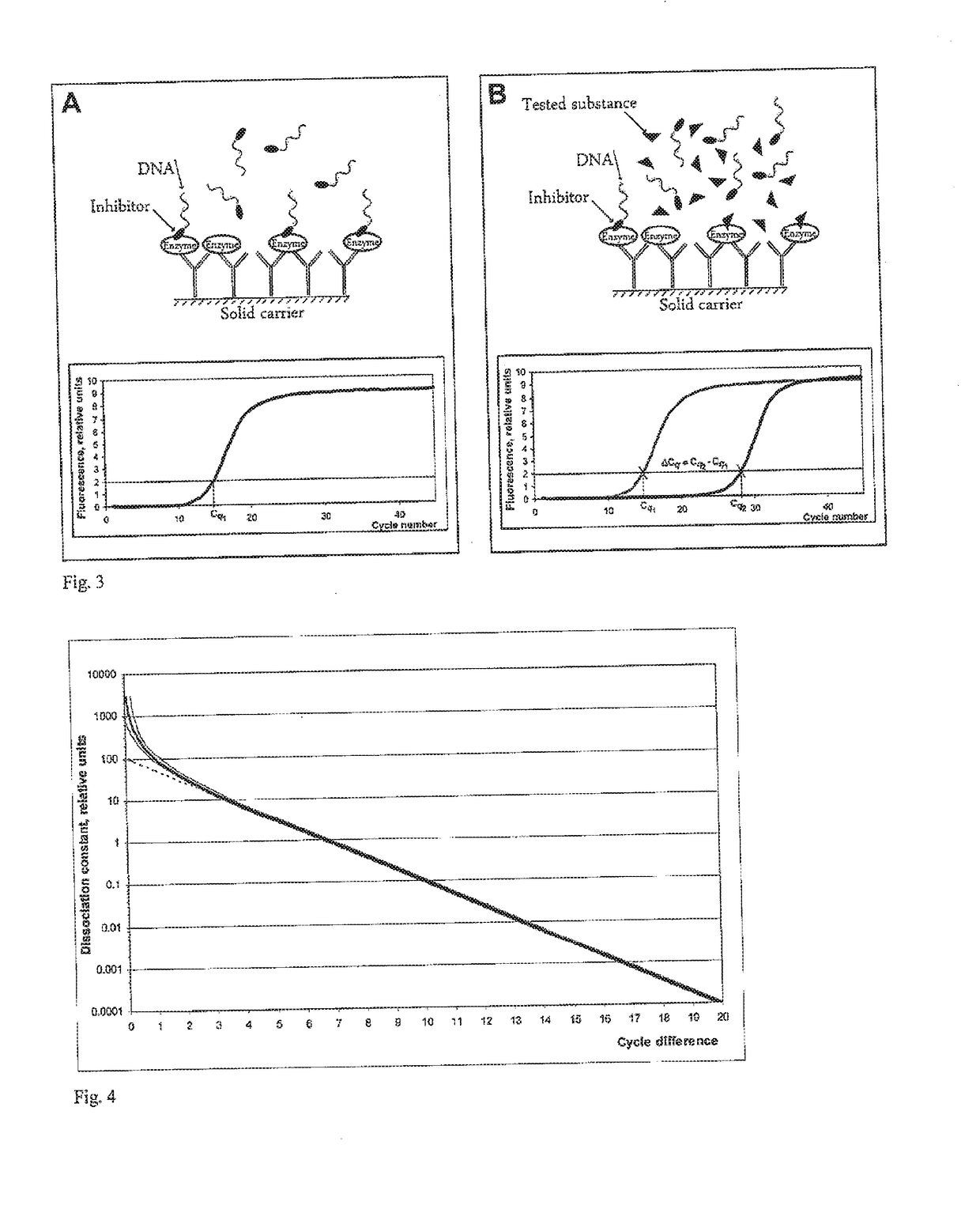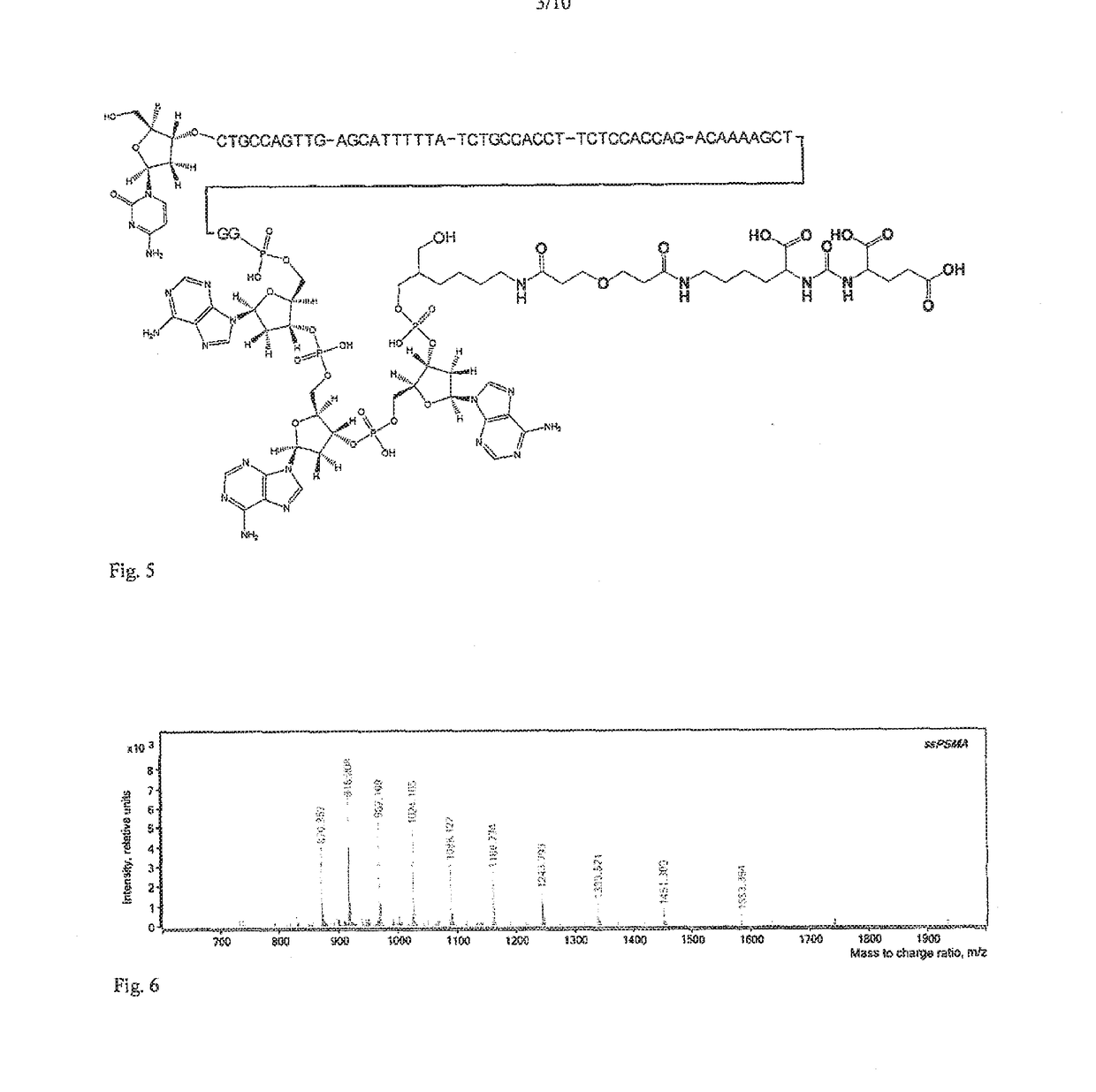Method of detection of analyte active forms and determination of the ability of substances to bind into analyte active sites
- Summary
- Abstract
- Description
- Claims
- Application Information
AI Technical Summary
Benefits of technology
Problems solved by technology
Method used
Image
Examples
Example
Example 1: Quantification of PSMA, Testing of PSMA Inhibitors Potency
1a: Preparation of PSMA Inhibitor with a Linker and an Activated NHS Ester
[0204]The detection probe for PSMA was prepared by linking of an urea based PSMA inhibitor S,S-2-[3-[5-amino-1-carboxypentyl]-ureido]-pentanedioic acid to the DNA. Following derivatives of the inhibitor were prepared: inhibitor with linker with terminal NHS-ester (Compound 3) for linking to the amino group of the DNA oligonucleotide and this compound reacted with ethanolamine (Compound 4) for determination of the impact of linking of the DNA oligonucleotide on the inhibition potency.
[0205]All chemicals were purchased from Sigma-Aldrich, unless stated otherwise. The purity of compounds was tested on analytical Jasco PU-1580 HPLC (flow rate 1 ml / min, invariable gradient 2-100% (vol. / vol.) ACN in 30 minutes, RT shown for each compound) with column Watrex C18 Analytical Column, 5 μm, 250×5 mm. All final products were purified using preparative sc...
Example
[0242]As demonstrated in the previous example 1e, the detection probe for PSMA binds also into the active site of its close homologue GCPIII. Selectivity of the determination was therefore tested by the same procedure as above; besides the 10 μl of rhPSMA solution, 10 μl of a solution of purified tagged and biotinylated Avi-GCPIII, or 10 μl of solution of purified extracellular portion of the human GCPIII prepared by recombinant expression (hereinafter rhGCPIII, prepared according to the procedure in (Hlouchová et al. 2007, Journal of Neurochemistry, p. 682)), were applied to the other wells, both at various concentrations ranging from 1 ng·μl−1 to 0.1 fg·μl−1. A solution of ssPSMA probe in CaSDS at a concentration of 1000 pmol·l−1 was used for the detection. While rhPSMA was detectable even at the lowest application quantity of 1 fg, with all applied quantities of Avi-GCPIII or rhGCPIII except the two highest (1 and 10 ng), there was no detectable difference from the wells without ...
Example
Example 2: Detection of HIV-1 Protease, Testing Potency of HIV-1 Protease Inhibitors
2a: Preparation of an HIV-1 Protease Inhibitor with a Linker and an Activated NHS Ester
[0266]The detection probe for HIV-1 protease was prepared by linking of a HIV-1 protease inhibitor with linker with terminal NHS-ester (Compound 7) with the amino group of the DNA oligonucleotide. Compound 8, prepared by reaction of Compound 7 with ethanolamine was used for determination of the impact of linking of the DNA oligonucleotide on the inhibition potency. All compounds were purified and characterized as described in example 1a.
[0267]Ritonavir (RTV, available under the brand name Norvir from Abbott Laboratories) was isolated from commercially available capsules in which RTV is suspended in an oily mixture of rather nonpolar compounds. 50 tablets (100 mg RTV each) were cut open and the oily substance was squeezed out into a bottom round shaped 21 flask. 200 ml of hexane was added along with 500 ml of diethy...
PUM
| Property | Measurement | Unit |
|---|---|---|
| Mass | aaaaa | aaaaa |
| Concentration | aaaaa | aaaaa |
| Affinity | aaaaa | aaaaa |
Abstract
Description
Claims
Application Information
 Login to View More
Login to View More - R&D
- Intellectual Property
- Life Sciences
- Materials
- Tech Scout
- Unparalleled Data Quality
- Higher Quality Content
- 60% Fewer Hallucinations
Browse by: Latest US Patents, China's latest patents, Technical Efficacy Thesaurus, Application Domain, Technology Topic, Popular Technical Reports.
© 2025 PatSnap. All rights reserved.Legal|Privacy policy|Modern Slavery Act Transparency Statement|Sitemap|About US| Contact US: help@patsnap.com



